The “Tribals” were a class of Canadian helicopter destroyers, radically larger ships than previous ASW escorts all derived from a 1949 design and saluted as possibly NATO’s best north Atlantic escorts when commissioned. They were far less ambitious still, than the previous guided missile destroyers projects, but for budgetary reasons, a far more focused and economical path was chosen. The aircraft carrier Bonaventure was scheduled out, the armed forces were unified, and the planned eight carrier escorts (also named Tribals) planned in 1963 with their Tartar SAM were dropped for a new generation of larger, better overall ASW ships. The new “tribals” were indeed a success, staying in serve way past the end of the cold war thanks to their generous TRUMP upgrade. Iroquois, Huron, Athabaskan, Algonquin, commissioned in 1972-73 remained indeed active until 2005-2017.

HMCS Huron in 1976
Development
The new “Tribals” were a less ambitious program than the cancelled previous missile frigates by the new government. They constituted however a step-up in terms of size and capabilities compared to the St Laurent class, being twice as large with a deep load of 5,100 tonnes when modernized. They were named DDH and later DDG, helicopter-carrying, guided missile destroyers, which they became under the TRUMP modernization program in the 1980s. Basically these “tribals” (named after local indian nations) were ordered in 1968 based on the past development, same hull as the cancelled GPF of 1960, but a rather conventional armament, however two hangar to carry heavy duty helicopters, a force multiplier.
When completed in 1972-73 they were saluted by the international naval press as ones of the most powerful escort ships in the world. Their large hull was tailored to present a massive superstructure followed by two hangars either side of the exhaust funnel, lattice mast, wide helideck and lower aft deck with a VDS. They jad a forward Italian OTO Melara 5-in guns forward and ASWRL mounted forward of the main bridge. Contrary to previous designs, they adopted an Italian rapid fire gun and Dutch radars.

HMCS Iroquois after TRUMP in the 1990s
The game changer was the set of radical reforms triggered by a government change: Disbandment of the unique Banshee fighter aircraft squadrons, retirement of modernized WW2 destroyers in the early 1960s, made a gap of air cover and fire support capabilities that would be fulfilled by the new planned General Purpose Frigate (GPF) design in 1963. For the first time, Canada was about to gain a guided missile destroyer. However rising costs of the program led to the Defence Minister, Paul Hellyer, to cancel the GPF program on 24 October 1963.
Still, the RCN continued tried to achieve a new design that could retain the lost capabilities and several designs were tested, one as a better version of the GPF still with missile, ASW rocket launcher and large calibre gun. By September 1964, Hellyer ordered however wanted instead a pure ASW design. The Royal Canadian Navy submitted one which complied to his will for steam turbines instead of gas turbines to spare money, for ideall a planned cost of $35 million, like the latest St. Laurent class derived destroyers.
On 22 December 1964, Hellyer announced the construction of four new helicopter-capable ASW destroyer escorts as the centerprice of a new procurement for the navy. Before construction was ordered however, the design phase laster for four more years as there was the need to accommodate and care for larger helicopters, as well as accomodating a new generation variable depth sonar but also a political pressure over a better industrial distribution across the country.
The final result was better balanced despite the loss of a SAM, than the previous GPF, with the originally planned twin semi-auto 5-inch (127 mm) gun mount replaced by a single mount, fully automatic 5-inch of the latest model. Instead of a RIM-24 Tartar, now considered largely obsolete and taking a lot of internal space, the new design adopted instead the smaller, short range defensive RIM-7 Sea Sparrow. This new generation however could take on both missiles and aircraft and also added to the active defence of the ship, something both the GPF and exiusting AW escorrts lacked. Facing a recruitment crisis common to many navies in the 1960s, the RCN planned to assign to these ships personnel for the discarded aircraft carrier Bonaventure. In December 1967, these helicopter destroyers were officially announced in the new 5-year Canadian procurement program.
In 1968, contracts were awarded to Davie Shipbuilding at Lauzon in Quebec as well as Marine Industries at Sorel also in Quebec. The final assembly was done on the French-speaking east coast, but suppliers were sourced across the country. The final drawings however were long in coming and only published when the keels were already laid down in 1969. The entire program cost was $252 million so $63 per ship on average, versus $35 planned for the GPF in 1963. This was due to poor management by the departments that governed the project and the program was almost cancelled whereas the ships were still pre-launch. Heads rolled, including in senior positions at National Defence Headquarters. The new ships were eventually commissioned in 1972–73, maintaining the memory of the famous interwar Tribal-class destroyers, and first major warships built in Canada in WW2.
For the training of new recruits, the RCN had a new centre created ashore reproducing the combat center of these ships and all their computer system, far more advanced at the time compared to the rest of the RCN. This extra automation also impacted the crew of 258, plus 30 dedicated to the air group. In comparison the previous, twice smaller Annapolis class felt crampier with 228 crew. The larger hull was better design and essentially added a full extra deck.
Design of the class
Hull and general design
The Iroquois class had a revised design with a taller hull, constant deck height and higher freeboard, slight slope at the prow, and lower aft deck mid-way below the helideck. The while aft deck was dedicated to ASW weaponry and the VDS. Like previous designs, the superstructure was massive and blocky, with an enclosed citadel, bridge and machinery spaces, full NBC protection.
Sources disagree on the specs with Conway’s book (Gardiner and Chumbley) stating a displacement of 3,551 standard, and 4,700 long tons (3,608 and 4,775 t) fully loaded, 423 feet (129 m) long overall, 398 feet (121 m) at the waterline, and a beam of 50 feet (15 m), draught of 14 feet 6 inches (4.42 m).
Macpherson and Barrie states they displaced less at 4,500 long tons (4,600 t) standard but were longer at was 426 feet (130 m) overall for the same beam at 50 feet (15 m) but a superior draught of 15 feet (4.6 m), plus a complement of 244 total, including the air crew.
Powerplant
The Iroquois reverted from the 1964 (poor) decision of steam turbines back to a more modern and flexible COGOG (Gas or Gas) system. This comprised for two shafts, of two Pratt & Whitney FT4A2 gas turbines rated for 50,000 shaft horsepower (37,000 kW) and two Pratt & Whitney FT12AH3 lower pressure, cruising gas turbines rated for 7,400 shp (5,500 kW). They could be coupled and decoupled at will, and combined together for a top speed of 29 knots (54 km/h; 33 mph) instead of 28 kts on the previous Annapolis, and a range of 4,500 nautical miles (8,300 km; 5,200 mi) at 20 knots (37 km/h; 23 mph) instead of 4,570 nautical miles at 12 knots for the Annapolis, so the Tribals had “longer legs”.
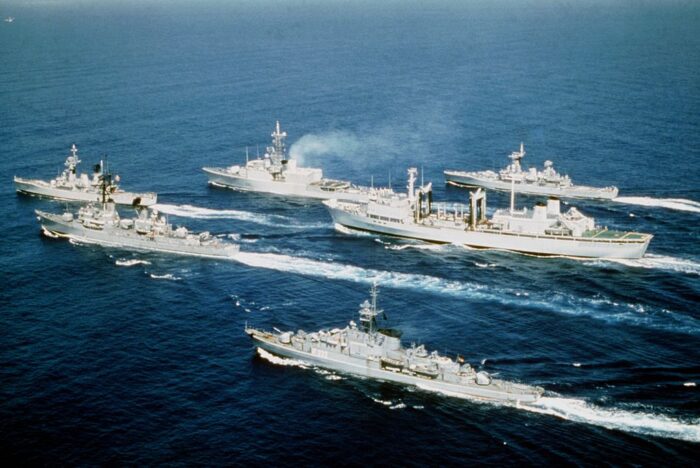
STANAVFORLANT, where all four sisters alternated as flagships.
Armament
The Iroquois class originally had been planned with an OTO Melara 5-inch (127 mm)/54 rapido capable of 40 rpm, with an anti-air defense limited to a single Mk III RIM-7 Sea Sparrow launcher, but ultimately twoo Sea Sparrow launchers were installed, each with four missiles for a full eight missiles on targets for point defense, 32 in store. They were located at the forward end of the superstructure, retracted into the deckhouse when none in use to be spared the winter North atlantic nasty waves.
This missile system was guided by a Dutch sourced Hollandse Signaal Mk 22 Weapon Control System. It was hiwever criticised for its deployment delay, from the housing, and warming-up the guidance system. The reload time or nearly ten minutes in an high intensity conflict was also another point, or that the FCS was Dutch, and did not mixed will with an US missile system. Lastly it was discovered these missiles were unable to stop sea-skimming anti-ship missiles.
The ASW suite comprised the always present Mk 10 Limbo anti-submarine mortar installed aft as well for short range by the also classic two triple Mk 32 torpedo tubes in trainable mounts, US type Mk 32 and their excellent Mark 46 acoustic torpedoes. Of course their greatest asset and raison dêtre was their pair of helicopters, which ensured long range multirole ASW patrols. The rule was to keep on ehelicopter in maintenance, one in flight at all time.
Sensors
The Tribals were given the following:
-Hollandse Signaal Mk 22 Weapon Control System to manage the missiles.
-Tactical air navigation system (TACAN).
-Litton CCS 280: Compressed version of the Automatic Data Link Plotting System (ADLIPS) electronic tactical system also installed
-LW-03 long range warning radar antenna
-SPS-501 long range warning radar.
-SPQ-2D low level air search, surface search, navigation, M22 fire control radars.
-SQS-501 bottom target classification sonar
-SQS-505 Hull-mounted sonar (14-foot/4.3 m dome).
-SQS-505 towed variable depth sonar, 18-foot (5.5 m) long.
Air Group
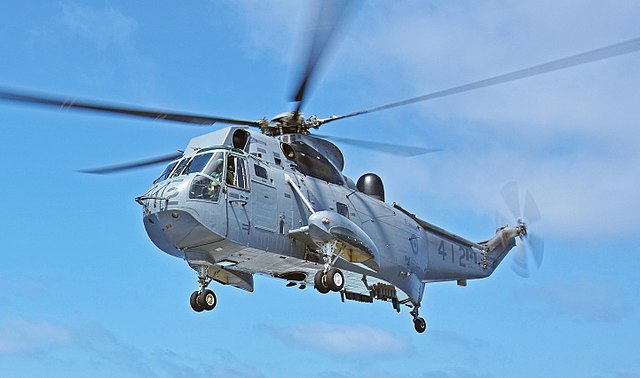
The Iroquois class for the bulk of their long range ASW operation could count on two Sikorsky CH-124 Sea King helicopters. For these, they had an approprioately large landing platform aft with a double hauldown and Beartrap hauldown device given their north atlantic use. The heliddeck platform was stronge and large enough to accomodate a Mil Mi-14 helicopter, as shown in a 1999 Baltic Sea operation with the Romanians. The Sea kings were large enough to carry a complete sensor suite and not only independently detect, but also track and strike a submarine given their on-board buoys, dipping sonar and two Mark 46 torpedoes. They greatly extended the range of the launch ship and a single Iroquois could for example cover both ASW flanks of a formation underway with its two helicopter deployed, before rushing on the more promising spot and take the relay with her own sensors and armament, leaving the helicopter searching in another sector. This made for a flexible hunter-killer combination.
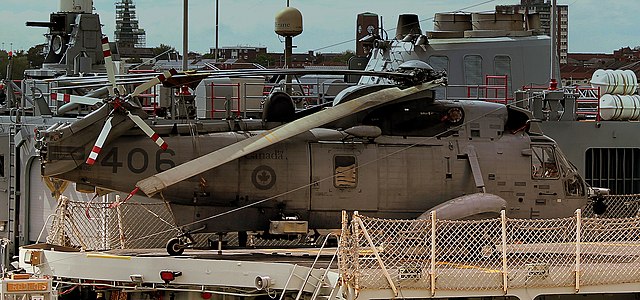
On board HMCS Iroquois at Liverpool in May 2013

⚙ specifications (1973): |
|
| Displacement | 3,351 t standard, 4,700 t DL |
| Dimensions | 128.9 m oa (121.3 pp) x 15.2 x 4.4 m (433 x 50 x 14 fts) |
| Propulsion | 2 shafts CODOG, 2 Pratt & Whitney FT4A2 gas turbines, 2 cruising turbines |
| Speed | 50,000 shp, and 7400 for the P&W FT12AH3 gas turbines, 29 knots |
| Armament | 1x 5-in/54 OTO DP, 320 mm ASWRL, 2×3 324 mm ASW TTs |
| Sensors | LW-08, STIR 1.8, SQS-501, SQS-505 |
| Air Group | 2 Sea King helicopters |
| Crew | 23 officers 232 ratings, +30 air crew |
TRUMP Upgrade
Modernizations (schematic)
TRUMP was done over several turns, for each ship: 1991 for Algonquin, 1992 for Iroquois, 1994 for Athabaskan and 1994 for Huron (see below).
In 1998-2000 their sonar suite (SQS-505(v)4, SQS-505(v)5 VDS) was replaced on all by the SQS-510(v)4, SQS-510 VDS, and Spectra 3000 sonars
In 1999 their ULQ-6B ECM suite and Corvus decoy RL were replaced by four Shield, and two Nulka decoy RL
In 2002 for Athabaskan, 2003 for Algonquin and 2004 for Iroquois their SHINPADS CCS was replaced by a combined Westcam 14 and Sirius e/o systems as well as the JMCIS CCS.
TRUMP Modernization
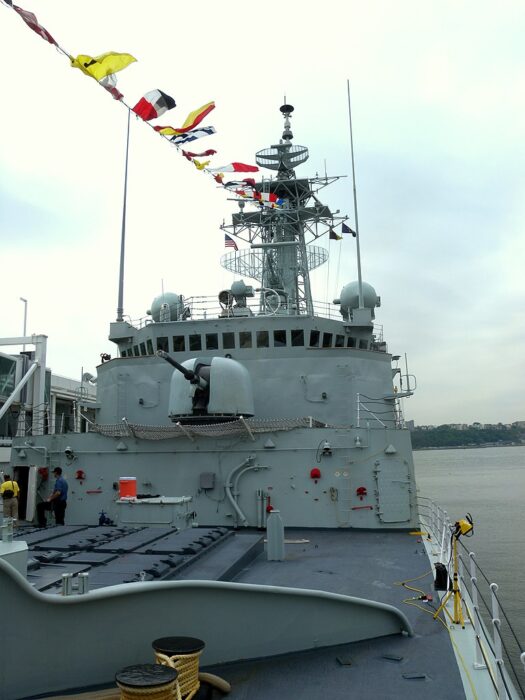
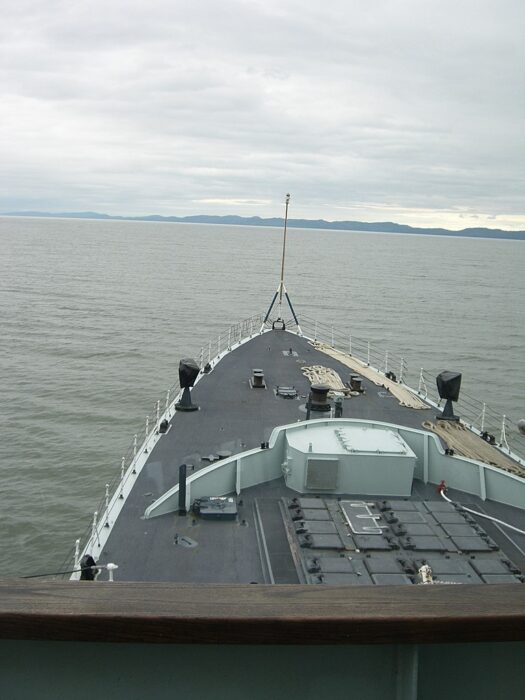
Foredeck of Athabascan and Algonquin showing their Main gun and VLS.
In 1986, they received funds for their long-awaited AAW program TRUMP for TR(ribal class) Update and Modernization Program. Litton Systems Canada Ltd.was awarded this major upgrade, in which the NL electronics were replaced by an all-US missile systems and guiding radars. In fact they obtained what was planned for the former GPF of 1963 wth a longer range SAM. But instead of the Tartar it was of course the Standard SM-2. Not only it offered both anti-aicraft, anti-missiles (if large enough) and anti-ship capabilities, but the closer range was actively defended by two trusted Phalanx guns.
The forward section had to be completely redesigned in order to house the Standard SAM silo launcher.
The 5-in gun was replaced by a much smaller 76 mm OTO Melara “super rapido” in B position. The space gained was allocated to the larger SAM reload system.
The Phalanx CIWS were installed aft on the hangar roof.
There were also changed in the powerplant, with the funnel exhaust modified for a lower heat signature. Inside the powerplant space, new GM Allison cruising turbines wetre istalled, providing more power, used for the more complex systems and electronics. In fact all the electronics on board were changed, Litton being a specialist. Not only the decoy launchers, but also the ESM and ECM systems.
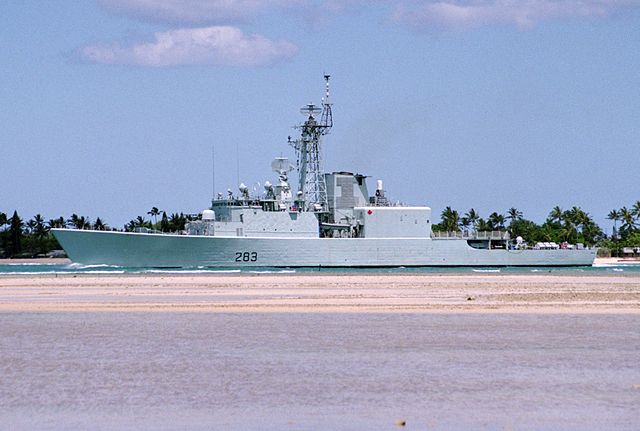
Algonquin at Pearl Harbor in 2000
HMCS Algonquin was modernized at MIL-davie in Lauzon, Quebec from 1987-91 followed by Iroquois in 1988 and the last two post-cold war in 1993. Given their “true” missile capabilities they were re-rated DDG-280 to 283 according to USN and NATO standards.
The program was initiated alonsgide the incoming Canadian Patrol Frigate Project, with a conversion of the Iroquois class from ASW ships to true anti-air warfare (AAW) vessels as planned back to 1963, as the new “City class” were ASW focused.
The new electronics also imposed a reconstruction of the superstructure, notably with a new derrick mast. They had a better CCS enabmed also a more complete command, control and communications (3C) which enabled the role of task group leaders.
The fact the program was awarded to the Quebec shipyards was to compensate the attribution of the Canadian Patrol Frigate Project to a New Brunswick shipyard. This was a $1.5 billion program fo Canadian taxpayers, which seems enormous (375 million per ship) compared to the 1963 35 million, of course, inflation came in between. Athabaskan was deployed with a partial TRUMP refit and an Mk 15 Phalanx CIWS was installed on her quarterdeck before deployment in Persian Gulf so that she could take part in the gulf war as part of the coalition.
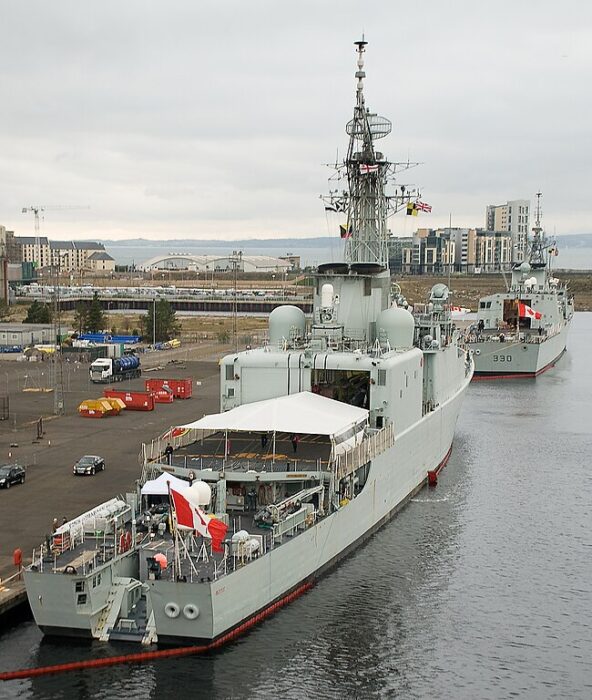
HMCS Athabascan showing her aft section, large hangar and new funnel, post TRUMP.
As a result of these modifications, the displacement rose to 5,100 long tons (5,200 t) deeply loaded and the propulsion was overhauled, counting on two GM Allison 570-KF cruising turbines as said above to replace their Pratt & Whitney FT12AH3. They were now rated for 12,800 shaft horsepower (9,500 kW) and the funnels lost their caracteristic twin outward-angled shape for a single large square funnel with thermal reduction outlets and the installation of a forced-air cooling system which both contributed to reduce the infrared signature.
The removal of the OTO Melara 5-inch gun was replaced bt a Mark 41 VLS for the new Standard SM-2 Block 2 (29 cell) but she kept a gun, however it was the smaller OTO Melara 76 mm (3 in) Super Rapido replaced in ‘B’ position repalcing the sea sparrows. The new Mk 41 VLS also imposed a reconstructed forecastle deck. The Mk 15 Phalanx CIWS were placed abaft the funnel. Of course as said above their gained new radar and sonar, new decoy launchers, and new SLQ-504 Canadian Electronic Warfare System (CANEWS) as well as the ULQ-6 system for electronic countermeasures. They gained thus a triple layer of active/pasive protection and a far more versatile and long range SAM, as the SM-2 could reach up to 92 nmi (74 to 170 km), 25,000 m (82,000 ft) ceiling at Mach 3.5. However the on board radar was more limited in multi-targeting than an AEGIS system.

Appareance after TRUMP, HMCS Iroquois
⚙ specifications as built |
|
| Displacement | 5,100 t full load |
| Propulsion | Same but GM Allison 570 KF cruising gas turbines |
| Armament | 1x 3-in/70 OTO SR, M41 Standard 2 SAM, Mk 15 Phalanx CIWS, 2×3 324 mm ASW TTs |
| Active Protection | shield DL, SQL-504 Canews,ESM, ILQ-6 ECM |
| Sensors | LW-08, STIR 1.8, SQS-505 |
| Air Group | 2 upgraded Sea King helicopters |
Career of the Tribals
 Iroquois (DDH/DDG 280)
Iroquois (DDH/DDG 280)
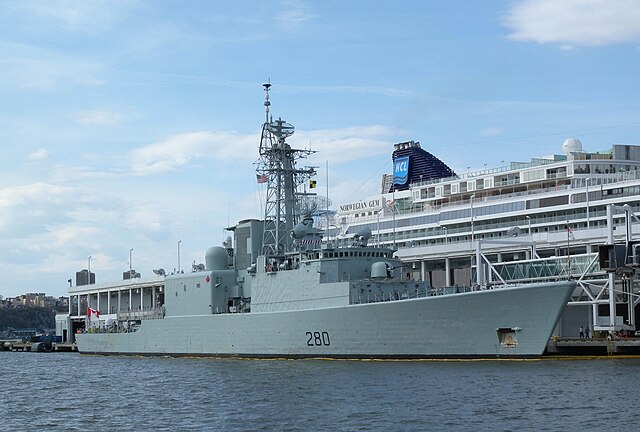
Iroquois was laid down on 15 January 1969 at Marine Industries, Sorel, Quebec. She was launched on 28 November 1970 and commissioned on 29 July 1972 as lead vessel. In 1978, she took part in NATO manoeuvers off Portugal and Denmark. She was also flaghip of STANAVFORLANT in 1878 and 1879. On 4 December 1983, she assisted the merchant vessel Ho Ming 5 and recued the crew as the ship was in danger of capsizing in a gale.
On 1 November 1989 she had her TRUMP refit first and became DDG-280. Work was completed on 3 July 1992, and her first important deployment was in the Adriatic from September 1993 to 25 April 1994 for the allied blockade force, sanctions on Yugoslavia. While there she boarded a number of vessels smuggling weapons to various parties. She relieved Algonquin as flagship of STANAVFORLANT.
On 17 June 1995 she became flagship, Maritime Operations Group 1 and received the first Canadian women in her crew from 1998 (first Canadian warship to do so). On 21 March 2000, she assisted the bulk carrier Leader L which, which disappeared northeast of Bermuda, rescuing thirteen survivors and six corpses. Post September 11 attacks saw her taking her place on the eastern North American flank to track aircraft entering North American airspace, in liaison with NORAD.
She took part in the operations in Afghanistan through Operation Apollo as part of a Canadian task group and she became flagship on 17 October, with the frigates Halifax and Charlottetown plus the supply ship HMCS Preserver, which arrived from 20 November. On her side, Iroquois joined an US amphibious ready group of the United States Marine Corps, escorting transports close to Pakistan and she was back in Halifax on 27 April 2002.
Post Iraq invasion of 2003 under Commodore Roger Girouard she led Task Force 151, composed of Canadian and allies, supporting also the War in Afghanistan. She replaced HCMS Fredericton, chosen first, but Commodore Girouard requested Iroquois due to her flagship accommodations and better communications suite. She sailed out on 24 February but lost her Sea King on the 27th (crash) and returned to have a new one. She departed Fredericton on 5 March but without helicopter and was back home in June.
In August 2006, she took part in Standing NATO Maritime Group 1 as flagship.
In 2008 she sailed to Somalia with Calgary and Protecteur as part of the multinational CTF 150, and herself was detached to watch over drug smuggling and piracy.
In 2012, Iroquois also took part in the war on drugs in the Caribbean Sea (Operation Caribbe).
However her 2014 inspection revealed rust was found in a machinery space, and hull structural cracks so she was laid up at Halifax by mid-April 2014 and it was decided to have her decommissioned by September 2014. Paid off on 1 May 2015, she was towed on 24 November 2016 from Halifax to Liverpool for BU.
 Huron (DDH/DDG 281)
Huron (DDH/DDG 281)
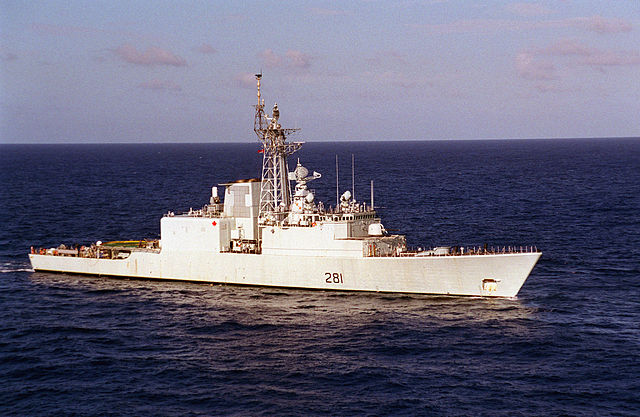
HMCS Huron was laid down on 1 June 1969 at Marine Industries of Sorel, launched on 9 April 1971, commissioned on 16 December 1972.
She was assigned to Maritime Forces Pacific (MARPAC), Esquimalt Naval Base, pacific seaboard. She was also deployed on long range missions throughout the Pacific and Indian Ocean. She represented Canada for the Silver Jubilee of Elizabeth II and naval review at Spithead on 28 June 1977. On 12 March 1980 she assisted the crippled freighter Maurice Desgagnes and rescued the crew before she sank.
From 19 February to 24 February 1981, she tested the Sea Sparrow system and carried the Governor-General Edward Schreyer for a tour of Scandinavian ports. In the summer of 1990 she made the first Russian visit since WW2 at Vladivostok with HMCS Kootenay and HMCS Annapolis.
She was sent to the Persian Gulf in 1991 for Operation Friction, Canadian contribution to Desert Storm, relieving HMCS Athabaskan as flagship of the local Task Group. She patrolled the area for months and returned to Esquimalt. In 1993 Huron she was in the Adriatic Sea for Operation Sharp Guard UN naval embargo on the former Yugoslavia in civil war.
In July 1993 she had her TRUMP refit at MIL-Davie Shipbuilding, Lauzon, completed by November 25, 1994.
Next she took part in several naval exercises in the Pacific. On 7 September 1999 the Mounted Police and personnel from Immigration Canada boarded her to arrest a vessel carrying 146 Chinese migrants, found to be unfit so she carried the passengers to Esquimalt.
She was on TV after the shooting of “The Devil and the Deep Blue Sea” (Seven Days serie) when encountering a USN vessels under command of a female captain.
Her general state had her mothballed in 2000, but this was mostly due to personnel shortage after defence cutbacks and she was paid off on 2005. 2006 MARPAC decided to end her as a target, in a sink-exercise by MARCOM, Operation Trident Fury in which the US Navy and AIRCOM aircraft participated, with other ships also sunk that day. It was decided to have her shelled, hit by missiles and strafing fire. She was badly damaged and finish off by a submarine torpedo but survived. Towed to port she was stripped of armaments and environmentally harmful contaminant equipment and fuel and on 14 May 2007, towed to the MARPAC offshore weapons range west of Vancouver. She took a hit from a Sea Sparrow, 57 mm and CIWS rounds but was finished off by 76 mm rounds from Algonquin, the first operational sinking of a Canadian warship close to home. This was documented in the TV programme “Sinking a Destroyer”.
 Athabaskan (DDH/DDG-282)
Athabaskan (DDH/DDG-282)
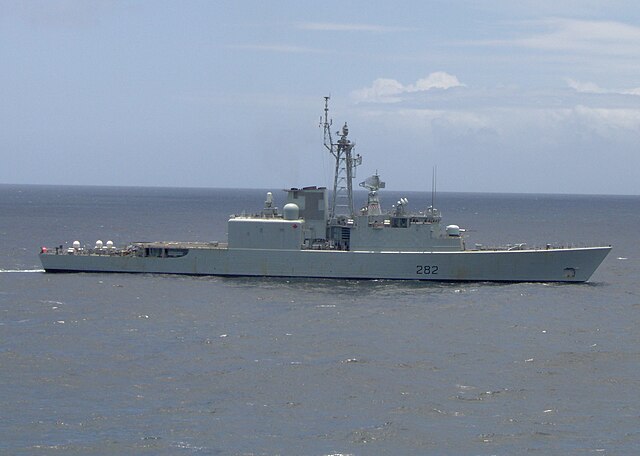
HCMS Athabaskan was laid down on 1 June 1969 at Davie Shipbuilding, Lauzon and was launched on 27 November 1970. She was officially commissioned on 30 September 1972 and like her sisters underwent her major TRUMP upgrade from 4 June 1994 to become DDG-282, still under Maritime Forces Atlantic (MARLANT) and operating from CFB Halifax, Nova Scotia.
She was tasked of Canadian sovereignty protection missions in the Atlantic and between territorial waters and Exclusive Economic Zone (EEZ), plus many cruises to the Atlantic and Indian Ocean, especially the middle east post cold war.
The 1970-80s were occupied by several high profile NATO missions notably as flagship or regular participants in Standing Naval Force Atlantic (STANAVFORLANT) later the Standing NATO Response Force Maritime Group 1 (SNMG1). On 2–3 August 1999 she trained in Baltic Sea seeing that a Polish Mil Mi-14 could be operated from her helideck. From August 1990, she was sent for Operation Friction in support of Operation Desert Shield rmed with a CIWS before her TRUMP upgrade. Became flagship of the Canadian Naval Task Group in the same formation as HCMS Terra Nova and Protecteur located in the central Persian Gulf and operating with other coalition navies.
From January 1991 she escorted hospital ships and other utility and supply vessels of the coalition and she was called for assistance of USS Princeton when she hit two Iraqi bottom-moored influence mines. In fact her commanding officer specifically requested the Canadian ship’s assistance as she could operate two large CH-124 Sea King helicopters. They were deployed to search for more mines over several days. This was until the minesweeper USS Adroit arrived to escort the Tico class cruiser our of the minefield. Athabaskan winched over on her several cases of beer for her crew, a custom many RN ships also did in WW2 as it was decided in the USN long ago to replace alcohol by ice cream. Athabaskan remained on station until after the war ended, relieved by Huron. Later back in American waters she unloaded supplies at Naval Air Station Pensacola after the ravaged of Hurricane Katrina, deployed afterwards on the Mississippi from 2 September 2005, to assist disaster relief efforts.
On 14 January 2010 she took part in Operation Hestia, to Haiti, also for disaster relief efforts after an earthquake. Her crew concentrated efforts in the city of Léogâne and assisted in triage for the Canadian Assistance Team, having the advantage ofmany French-speaking interpreters.
However whatever her humanitarian efforts were, time caught up with the 1970 hull. Between engine failures and maintenance probkems she spent more and more time in repairs. On 8 September 2015 she took part in NATO’s Joint Warrior and Trident Venture alongside HMCS Windsor, Halifax, Montréal, Goose Bay and Summerside. Her starboard cruise engine failed however while in the Atlantic but she managed to reach the United Kingdom, closer, to be later repaired by a mobile repair team. The engine. was replaced. In January 2016 she was fitted the first with AN/USC-69(V3) antennas for satcom upgrade (STSCU) and better integrations unto US TFs. She thereafter took part in Cutlass Fury off the east US coast.
In September 2016, she was announced to be paid off in 2017, replaced by the planned Canadian Surface Combatant. Her last port visit was in Bermuda and she made a family crew and carried pas crew members on 7-8 March, making a last hello to Halifax Harbour on 10 March, then paid off. By February 2018 the Marine Recycling Corporation was awarded CA$5.7 million to be BU at Sydney, Nova Scotia, now complete.
 Algonquin (DDH/DDG-283)
Algonquin (DDH/DDG-283)
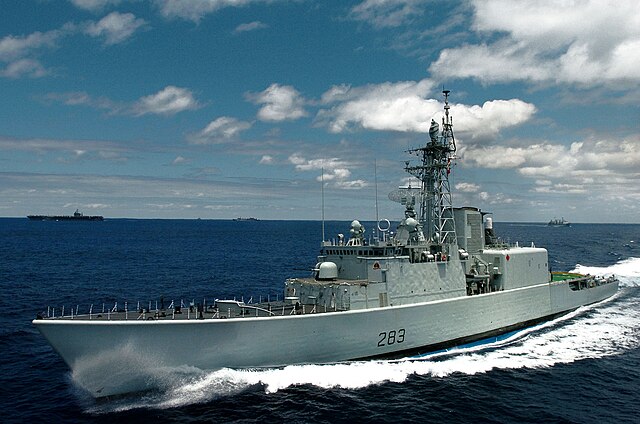
HCMS Algonquin was Laid down on 1 September 1969, Launched on 23 April 1971 and commissioned on 3 November 1973. On 9 November she proceeded to her first crew readiness work-ups and embarked her first CH-140 Sea King. She was assigned Halifax on 28 November and took part in MARCOT 3/73 with HCMS Yukon and Assiniboine.In 1974, she rescued the fishing vessel Paul & Maria 130 kilometres east of Halifax. On 10 January 1975 she was in UKn at Portland flagship STANAVFORLANT with USS Edward McDonnell. On 21 May she led a TF with the oiler Protecteur, Iroquois, Skeena and Margaree for Bermuda and MARCOT 75.
In August 1976 she launched her helicopters in SAR for Peggy’s Cove after a collision with Arosia. On 8 November, she took part in fishery protection, arresting two Cuban fishing vessels violating Canadian Coastal Fisheries Laws. On 12 January 1977 she took part in CARIBEX 1–77 with Assiniboine, Protecteur and Margaree and Springboard 77 off Puerto Rico, later as flagship of First Canadian Destroyer Squadron.
On 27 May 1978 she gained the awarded the L.W. Murray Trophy for gunnery excellence plus the 20 Knot Mortar Firing Trophy. On 28 August she left Halifax for Northern Wedding. On 26 September she was flagship for STANAVFORLANT, relieving Huron. From 15–18 November in STANAVFORLANT she led extensive ASW operations in the Baltic Sea and in 1979 as well, tracking and shadowing soviet subs in the North Atlantic.
She was refitted in 1981 and later won again the ASW Proficiency Shield and 20 Knot Trophy. On 26 January she had a fire in the forward decontamination compartment, caused by toilet paper and the steam radiator, quick mastered. In November she was in exercises with the submarine HCMS Okanagan. During her refit she gained the Surface and Air Weapon Information System a FCS and 84 tons of aft ballast. She took part in MARCOT 2/81 and later to CARIBOPS 82, STANAVFORLANT over 5 months as flagship.
She launch her sea kings to look for the pilot of a ditched A7 Corsair II off Puerto Rico. In February she was at CARIBOPS 82, and later off Martinique she assisted the powerless diving support vessel Cormorant and towed her to Bridgetown, Barbados. In March she was at SAFEPASS 82 for convoy procedures. In August she was in STANAVFORLANT, North Sea as flagship, was off the Shetland Islands for Exercise Northern Wedding 82, for an USN amphibious task force landing troops in Denmark. In October she trained the Danish Navy in the Western Baltic and in November, with the Royal Navy for JMC 824 and in December, the French Navy in the English Channel.
In February 1983, she was at CARIBOPS 83, by June at MARCOT 1/83 (Bermuda), in October MARCOT 2/83, and she was in the Gulf of St. Lawrence and by February 1984, she guarded USS Independence CBG for 36 days. In April she was drydocked in Montreal and returned to Bermuda. In 1985 she had no helicopter complement.
In early 1985 she was in patrols and was anchored in Bedford Basin the RCN’s 75th anniversary, also in June in the Saint Lawrence River. From August she was at OCEAN SAFARI and by March 1986 was in fishery protection off Cape Rogers, arresting a Panamanian fishing trawler. In February 1987 she was at CARIBOPS 87, joined STANAVFORLANT in March–May as flagship, then Ex. Open Gate off Gibraltar and NATO’s Ex. “Vendetta”, North Sea. She later proceded to Quebec to start her long and costly TRUMP refit from 26 October 1989 to 11 October 1991. Stability tests nearly had her collapse.
On 29 March 1993 she was bacl at STANAVFORLANT as flagship before being sent to former Yugoslavia for Operation Sharp Guard. On 2 July she started one of 88 merchant vessel boardings, on 27 July, seven ships alone. On 5 October she was back at STANAVFORLANT, handed over her role to HMCS Iroquois and was back home.
In 1994 she was reassigned to the west coast, Esquimalt, via Panama and in 1995, she was at several exercises such as COMPUTEX and MARCOT and escorted USS Carl Vinson CBG.
In February 1996, she took part in FLEETEX 96-1A with Protecteur, Regina and Winnipeg, still with USS Carl Vinson and on 18 February she sailed for Yokosuka via the Aleutian Islands as part of WESTPLOY 96 with Preserver, Regina, Winnipeg and Vancouver. On 3 April she met the JSDMF Ayase and Ishikari south of the Kuril Islands for Operation Maple-Cherry. On 3 May they were south of Inchon to train with ROKS Kyong Buk and Che Ju. They then sailed for Pearl Harbor in June for RIMPAC 96 and bacl to Esquimalt on 27 June. Later she gathered intel on a suspecious Russian merchant vessel in Canadian waters, and escorting her to the Juan de Fuca Strait. Next she had a refit which ended in April-May 1998.
On 24 August she tested her defenses with a private MiG-21 which crashed into the ocean but she could not fin the jet after a 24 hours search but vectored the Canadian Coast Guard, which instead spotted and arrested an illegal Chinese migrant vessel. The migrants were handed over the Royal Canadian Mounted Police for medical and legal processing.
After WESTPLOY 00 in April 2000 she sailed for China, Qingdao, and with Winnipeg conducted exercises with the Chinese Navy (PLAN). In June she was part of 54 ships of several navies at RIMPAC 00 and in 2001 resumed work as flagship for the Commander Canadian Fleet Pacific. She later took part in Operation Apollo and trained with US-ANZAC navies.
Next she was in the Gulf of Oman via Saipan, Guam, Malaysia, Thailand, Hong Kong and the UAE. There she took part in Operation Apollo and on 14 October departed for Esquimalt after 7 months, 55,000 nautical miles, spotting 1,700 vessels and boarding 55., with 96 inspections of “go-fast” of smugglers and suspected terrorists.
After a short refit in March-August 2003 at Victoria Shipyards she returned as flagship in the Pacific and more exercises in 2005, she also visited San Francisco, Vancouver and Calgary and returned in refit in 2008. On 30 August 2013 she collided with Protecteur in towing manoeuvres off Hawaii, no injuries but she was repaired in Esquimalt for damage on her port side hangar.
She was to be discarded in 2019, and given the cost of repairs, on 19 September 2014 it was announced she would be be paid off, effective on 11 June 2015, she was sold for scrap on 27 November 2015 and towed to Liverpool in Nova Scotia for BU.
Read More/Src
Books
Barrie, Ron; Macpherson, Ken (1996). Cadillac of Destroyers: HMCS St. Laurent and Her Successors. Vanwell Publishing Limited.
Gardiner, Robert; Chumbley, Stephen; Budzbon, Przemysław, eds. (1995). Conway’s All the World’s Fighting Ships 1947–1995.
German, Tony (1990). The Sea is at Our Gates: The History of the Canadian Navy. Toronto: McClelland & Stewart Incorporated.
Gimblett, Richard H., ed. (2009). The Naval Service of Canada 1910–2010: The Centennial Story. Toronto: Dundurn Press.
Macpherson, Ken; Barrie, Ron (2002). The Ships of Canada’s Naval Forces 1910–2002 (Third ed.). St. Catharines, Ontario: Vanwell Publishing Limited.
Milner, Marc (2010). Canada’s Navy: The First Century (Second ed.). Toronto: University of Toronto Press.
Moore, John, ed. (1981). Jane’s Fighting Ships 1981–82. New York: Jane’s Publishing Incorporated.
Tracy, Nicholas (2012). A Two-Edged Sword: The Navy as an Instrument of Canadian Foreign Policy. Ontario: McGill-Queens University Press.
Links
https://web.archive.org/web/20090703062007/http://www.navy.forces.gc.ca/iroquois/1/1-s_eng.asp?category=1&title=570
https://www.thecanadianencyclopedia.ca/en/article/iroquois-class-destroyers
http://www.hazegray.org/navhist/canada/postwar/tribal/
https://www.naval-technology.com/projects/iroquoisclassairdefe/
http://www.hazegray.org/navhist/canada/current/iroquois/
https://en.wikipedia.org/wiki/Iroquois-class_destroyer
http://www.navypedia.org/ships/canada/can_dd_iroquois72.htm
https://www.marinerecycling.ca/news/article/mrc-awarded-contract-for-hmcs-athabaskan
https://www.cbc.ca/news/canada/nova-scotia/hmcs-protecteur-liverpool-1.3466327
https://www.cbc.ca/news/canada/2-canadian-warships-collide-en-route-to-hawaii-1.1309679
https://www.canada.ca/en/navy/services/history/ships-histories/iroquois.html
https://www.cbc.ca/news/canada/nova-scotia/hmcs-iroquois-sidelined-indefinitely-after-rust-found-in-hull-1.2635322
https://web.archive.org/web/20231004021052/https://macleans.ca/news/canada/canadas-last-cold-war-destroyer-retires-after-one-last-sail/
https://www.ctvnews.ca/canada/navy-sending-four-cold-war-era-ships-into-retirement-1.2014607
https://archive.org/details/seaisatourgatesh00germ
https://www.globalsecurity.org/military/world/canada/hmcs-iroquois.htm
https://www.silverhawkauthor.com/post/royal-canadian-navy-destroyers-iroquois-class-hmcs-iroquois-ddg-280-hmcs-huron-ddg-281-hmcs-athabaskan-ddg-282-and-hmcs-algonquin-ddg-283-1972-2017
video
Model Kits
HMCS Iroqouis: The Resin Shipyard No. C-02 1:350
12 inches model on sdmodelmakers.com

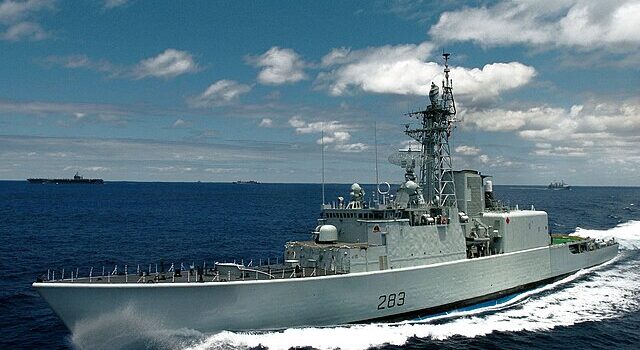
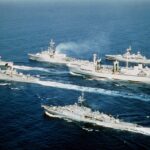
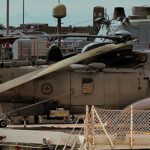
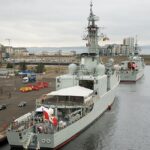
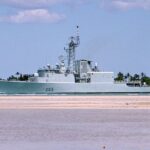
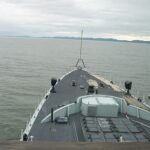
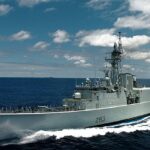
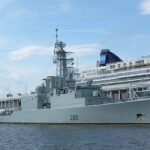
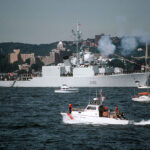
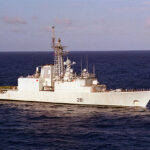

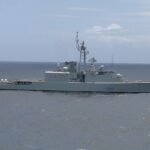
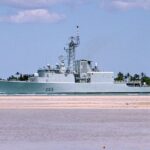
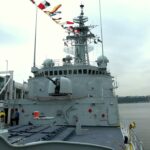
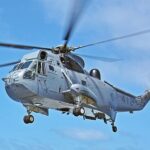
 Latest Facebook Entry -
Latest Facebook Entry -  X(Tweeter) Naval Encyclopedia's deck archive
X(Tweeter) Naval Encyclopedia's deck archive Instagram (@navalencyc)
Instagram (@navalencyc)





 French Navy
French Navy Royal Navy
Royal Navy Russian Navy
Russian Navy Armada Espanola
Armada Espanola Austrian Navy
Austrian Navy K.u.K. Kriegsmarine
K.u.K. Kriegsmarine Dansk Marine
Dansk Marine Nautiko Hellenon
Nautiko Hellenon Koninklije Marine 1870
Koninklije Marine 1870 Marinha do Brasil
Marinha do Brasil Osmanlı Donanması
Osmanlı Donanması Marina Do Peru
Marina Do Peru Marinha do Portugal
Marinha do Portugal Regia Marina 1870
Regia Marina 1870 Nihhon Kaigun 1870
Nihhon Kaigun 1870 Preußische Marine 1870
Preußische Marine 1870 Russkiy Flot 1870
Russkiy Flot 1870 Svenska marinen
Svenska marinen Søværnet
Søværnet Union Navy
Union Navy Confederate Navy
Confederate Navy Armada de Argentina
Armada de Argentina Imperial Chinese Navy
Imperial Chinese Navy Marinha do Portugal
Marinha do Portugal Mexico
Mexico Kaiserliche Marine
Kaiserliche Marine 1898 US Navy
1898 US Navy Sovietskiy Flot
Sovietskiy Flot Royal Canadian Navy
Royal Canadian Navy Royal Australian Navy
Royal Australian Navy RNZN Fleet
RNZN Fleet Chinese Navy 1937
Chinese Navy 1937 Kriegsmarine
Kriegsmarine Chilean Navy
Chilean Navy Danish Navy
Danish Navy Finnish Navy
Finnish Navy Hellenic Navy
Hellenic Navy Polish Navy
Polish Navy Romanian Navy
Romanian Navy Turkish Navy
Turkish Navy Royal Yugoslav Navy
Royal Yugoslav Navy Royal Thai Navy
Royal Thai Navy Minor Navies
Minor Navies Albania
Albania Austria
Austria Belgium
Belgium Columbia
Columbia Costa Rica
Costa Rica Cuba
Cuba Czechoslovakia
Czechoslovakia Dominican Republic
Dominican Republic Haiti
Haiti Hungary
Hungary Honduras
Honduras Estonia
Estonia Iceland
Iceland Eire
Eire Equador
Equador Iran
Iran Iraq
Iraq Latvia
Latvia Liberia
Liberia Lithuania
Lithuania Mandchukuo
Mandchukuo Morocco
Morocco Nicaragua
Nicaragua Persia
Persia San Salvador
San Salvador Sarawak
Sarawak Uruguay
Uruguay Venezuela
Venezuela Zanzibar
Zanzibar Warsaw Pact Navies
Warsaw Pact Navies Bulgaria
Bulgaria Hungary
Hungary

 Bundesmarine
Bundesmarine Dutch Navy
Dutch Navy Hellenic Navy
Hellenic Navy Marina Militare
Marina Militare Yugoslav Navy
Yugoslav Navy Chinese Navy
Chinese Navy Indian Navy
Indian Navy Indonesian Navy
Indonesian Navy JMSDF
JMSDF North Korean Navy
North Korean Navy Pakistani Navy
Pakistani Navy Philippines Navy
Philippines Navy ROKN
ROKN Rep. of Singapore Navy
Rep. of Singapore Navy Taiwanese Navy
Taiwanese Navy IDF Navy
IDF Navy Saudi Navy
Saudi Navy Royal New Zealand Navy
Royal New Zealand Navy Egyptian Navy
Egyptian Navy South African Navy
South African Navy






























 Ukrainian Navy
Ukrainian Navy dbodesign
dbodesign